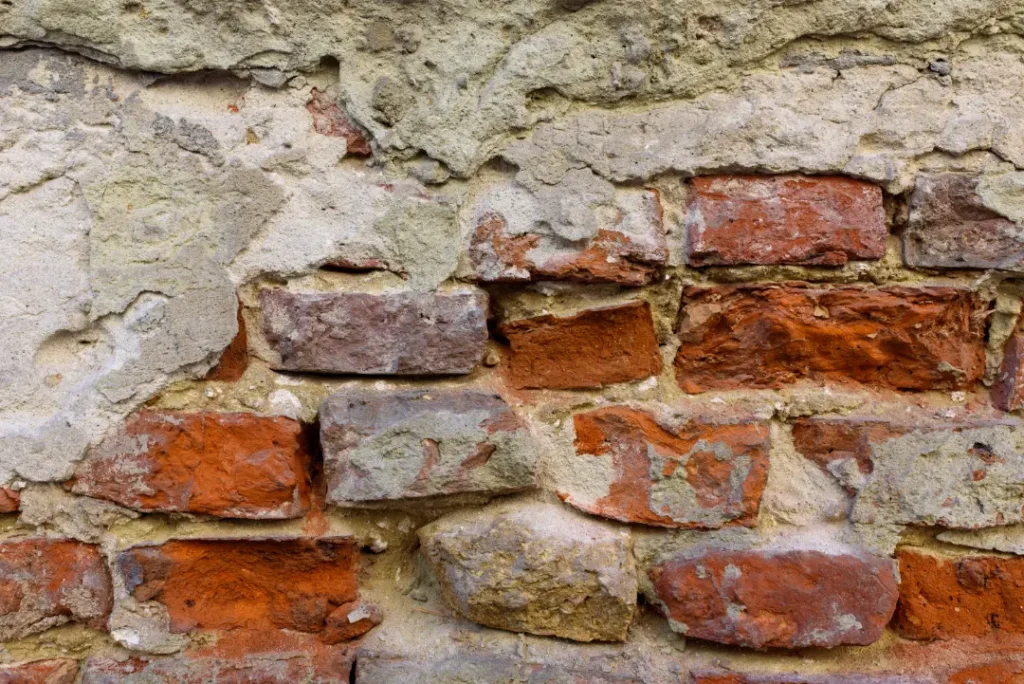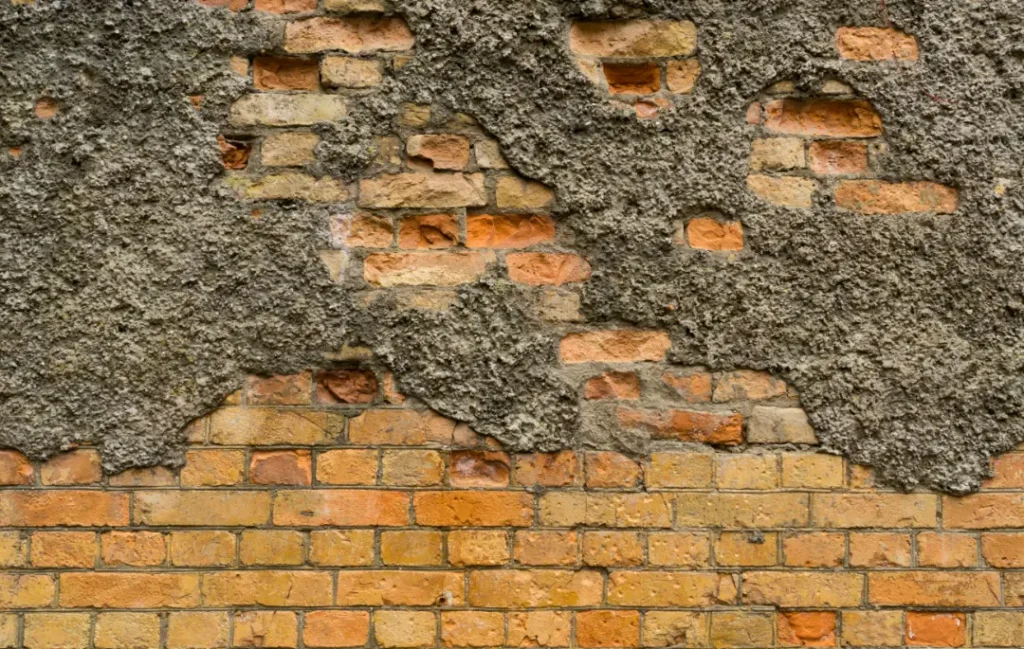Does repointing stop water? Yes, repointing can effectively prevent water penetration in masonry walls.
It involves renewing the mortar joints, which restores the structure’s integrity and creates a waterproof barrier.
In this article, we’ll explain how repointing works, its importance in preventing damp, and additional measures to protect your home from moisture damage.
Key Takeaways
- Repointing renews the mortar joints in masonry to prevent water penetration and maintain structural integrity.
- Using the correct materials, particularly lime mortar, is essential for effective repointing and moisture management.
- Professional repointing services can enhance property value and ensure a thorough, long-lasting repair that respects the original building materials.
Understanding Repointing
Repointing is the meticulous process of renewing the external part of mortar joints in masonry construction. This technique involves removing the old, damaged mortar from between the bricks and replacing it with fresh repointing mortar, ensuring the stability and appearance of the wall are maintained.
Common materials for repointing include lime mortar, particularly for buildings erected before 1920, and cement for more modern structures.
The primary goal of repointing is to prevent water penetration and maintain the structural integrity of masonry walls. It creates a protective barrier that helps prevent dampness and deterioration, safeguarding the building’s longevity and safety.
How Damaged Pointing Leads to Water Penetration
Over time, poorly maintained pointing can allow moisture to seep into the walls, causing significant damage.
When failed pointing occurs, it exposes the masonry to direct weather conditions, leading to water penetration and damp issues. This is especially problematic during cold weather, as freezing moisture can expand and cause further deterioration.
The consequences of water penetration are severe. It can lead to the loss of structural integrity, the development of black mould, and a general decline in the quality of the walls.
Ordinarily, mortar is expected to last around 25 years, but factors such as rain pooling around foundations and overflowing gutters can accelerate its deterioration. Regular maintenance and early intervention are essential to prevent these issues from escalating.
Modern cement use in pointing can sometimes worsen moisture problems by trapping moisture within the wall, leading to dampness and deterioration.
The Role of Repointing in Preventing Damp
Repointing plays a pivotal role in preventing damp by restoring the integrity of the mortar joints.
Lime mortar, in particular, is highly effective for this purpose due to its breathable nature, allowing moisture to escape rather than becoming trapped within the masonry. This breathability is crucial in managing moisture levels and preventing the formation of damp spots.
Unlike cement mortar, lime mortar also offers flexibility that accommodates structural movements without cracking, significantly reducing the risk of moisture ingress. Using pure lime mortars in repointing ensures that the wall can ‘breathe,’ enhancing its ability to manage moisture and maintain its structural integrity.
For stone walls, a hydraulic lime mortar is often recommended to ensure compatibility and durability.
Skilled repointers know how to choose the right materials and techniques to repair compromised mortar, effectively restoring the damp-proof layer and preventing water infiltration. This expertise is invaluable in ensuring the long-term health and resilience of the masonry.

Steps for Effective Repointing
Effective repointing is a meticulous process that involves several key steps to ensure both durability and aesthetic appeal. These steps include removing the old mortar, preparing the joints raked for new mortar, and carefully applying the new mortar during the re-pointing process.
Each step is crucial in ensuring that the new pointing can withstand weather conditions and maintain its integrity.
Remove the Old Mortar
The first step in repointing is removing the old mortar to a sufficient depth to provide a solid base for the new material. This depth is typically at least one centimetre. Tools like hacksaw blades and pointing trowels are essential for this task, enabling precise removal of the old mortar without damaging the surrounding brick or stone.
Proper removal is crucial; insufficient depth can undermine the new pointing’s effectiveness.
A pointing trowel helps ensure thorough removal of old mortar, which is vital for the new mortar’s optimal adhesion.
This step sets the foundation for the rest of the repointing process, ensuring that the new mortar will bond well and provide long-lasting protection.
Prepare the Joints for New Mortar
Once the old mortar has been removed, the next step is to prepare the joints for the new mortar. This involves cleaning the joints thoroughly and dampening them to enhance the bonding process.
Proper cleaning ensures that any debris or loose particles are removed, which can otherwise prevent the new mortar from adhering correctly.
Dampening the joints before applying new mortar is crucial. This prevents the surrounding masonry from absorbing too much water from the mortar, which can lead to rapid drying and poor adhesion.
This preparation step ensures that the new mortar will bond strongly and provide a durable, weather-resistant finish.
Apply the New Mortar
Applying the new mortar is a delicate process that requires a good, stiff lime mortar mix for flexibility and breathability. Lime mortar never fully dries out, allowing moisture to come and go, which is why it requires time to harden properly.
This characteristic makes it ideal for maintaining the health of the masonry over time.
Protecting the newly applied mortar from extreme weather conditions is crucial to prevent failure. Proper application and protection ensure that the new mortar will provide a robust and durable seal, maintaining the structural integrity and appearance of the masonry.
How to Choose the Right Mortar Mix
Selecting the right mortar mix is key to successful repointing. The compatibility of the mortar with the original materials significantly influences its effectiveness.
For older buildings, lime mortar is often preferable because it allows the masonry to breathe and manage moisture effectively. Lime mortar also enhances the aesthetic quality of the masonry by allowing the natural stone colours to show through, especially when using lime-based materials.
A common mix for lime mortar is:
- One part lime
- Four parts sand.
Sharp sand in the mixes can improve setting speed and stability, especially for stone walls and stones. Matching the suitable mortar mix to the specific needs of the masonry ensures a durable and aesthetically pleasing stonework finish that will stand the test of time.

Common Mistakes in Repointing
One of the most common mistakes in repointing is using modern materials for repointing old buildings. This can lead to improper moisture management and potential damage to the masonry. While pointing is meant to wear down over time due to weathering, using the wrong materials can accelerate this process.
Another mistake is performing patchwork fixes instead of comprehensive repointing. While patchwork may seem like a cost-effective solution, it often results in uneven strength across the wall, possibly leading to further issues.
Comprehensive repointing guarantees even strength and durability, reducing the need for frequent repairs, especially at the seams.
The Importance of Professional Repointing Services
Hiring professional repointing services ensures that the job is done correctly and efficiently. Professional repointers, like our team at Environ Property Services, have the expertise to address issues such as falling mortar and decaying joints, ensuring the structural integrity of the property.
Moreover, a professionally executed repointing service can increase a property’s value, and maintained homes are more appealing to buyers.

Environ Property Services: Expert Repointing That Stops Damp at the Source
At Environ Property Services, we provide professional brick repointing that can last for decades and also prevent damp from disturbing your walls.
Our expert masons understand that stopping water penetration takes more than surface-level patching. That’s why we carry out full-depth raking, select the correct lime mortar for your building’s age and structure, and apply it using time-tested techniques that allow your walls to breathe.
We specialise in restoring historic and period homes across London, using breathable, flexible materials that ensure proper moisture release while reinforcing the structure.
When you hire us, you get conservation-grade workmanship backed by years of experience dealing with London’s most stubborn damp issues. We pair traditional knowledge with modern diagnostic tools, checking for hidden moisture, frost damage, and underlying cracks before we ever mix a batch of mortar.
Don’t wait for the signs of damp to spread. Call us now for expert help.
Additional Measures to Prevent Water Penetration
Preventing water penetration goes beyond repointing. Effective prevention strategies involve:
- Maintaining building elements like gutters and drainage systems to prevent water from pooling around foundations
- Addressing drainage issues
- Managing weathering to slow down pointing deterioration
Regular inspections and timely repairs can significantly enhance the building’s resilience against the elements. These measures, coupled with proper repointing, form a comprehensive approach to protecting your masonry from water damage.
Frequently Asked Questions
What is repointing?
Repointing is the process of renewing mortar joints in masonry to ensure structural integrity and prevent water penetration. This essential maintenance helps prolong the lifespan of the construction.
How does damaged pointing lead to water penetration?
Damaged pointing compromises the integrity of masonry, enabling moisture to infiltrate the walls and resulting in damp problems.
Why is lime mortar recommended for repointing?
Lime mortar is recommended for repointing because it is breathable and flexible, facilitating moisture escape and accommodating structural movements, thereby preventing dampness.
What are common mistakes in repointing?
Common mistakes in repointing involve using inappropriate modern materials for historic structures and opting for patchwork repairs rather than undertaking thorough repointing efforts.
Why should I hire professional repointing services?
Hiring professional repointing services guarantees that the work is executed properly, preserving the structural integrity of your property and potentially enhancing its value. It is a wise investment for long-term maintenance and improvement.
Conclusion
Repointing is a critical maintenance practice that protects your masonry from water penetration and damp issues. By understanding the importance of using the right materials and techniques, you can ensure the longevity and structural integrity of your property.
Professional repointing services provide the expertise and attention to detail necessary to maintain the beauty and health of your masonry.
Investing in these practices not only preserves the structural integrity of your property but also enhances its value and aesthetic appeal.

